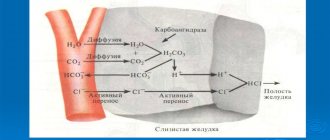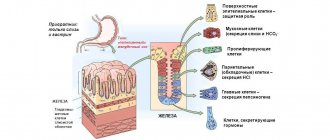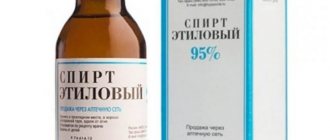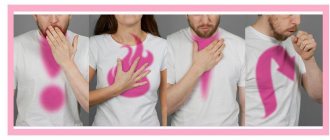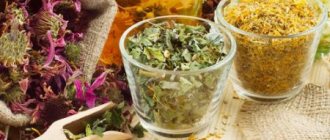Reduce gastric secretion
Men and women have slightly different rates of gastric juice secretion. At the same time, when the secretory function is impaired, the amount of gastric juice is produced in smaller or larger quantities. The average daily secretion of gastric juice reaches an average of two liters. Anything above this indicator is called hypersecretion. A small table shows the optimal indicators for women and men:
| Norm of gastric juice secretion in 60 minutes: | 80-100 ml | 60-80 ml |
| Acidity standards for different parts of the stomach: | pH value: | |
| For the antrum: | 1,3-7,4 | |
| For the surface of the epithelium of the body of the stomach: | Up to 2 | |
| For deep layers of epithelium: | Up to 7 | |
| Acidity in the body, the norm is indicated on an empty stomach | Up to 2 | |
Important! The color of gastric juice is transparent. An interesting feature is that even with increased work of the secretory apparatus, an increased amount of gastric juice may not be noticed.
Diet reduces the secretion of gastric glands
Nutrition with high acidity, despite some restrictions, must be complete in order to supply the patient’s body with the necessary amount of proteins, carbohydrates, vitamins and micro-macroelements
Nutrition with high acidity, despite some restrictions, must be complete in order to supply the patient’s body with what it needs the amount of proteins, carbohydrates, vitamins and micro-macroelements.
Allowed to eat:
- dried or “yesterday’s” bread;
- whole grain porridge;
- vegetable purees, salads and casseroles;
- boiled lean meats and fish;
- dairy food;
- non-acidic fruits;
- puree soups.
Any smoked foods, pickles, marinades, fatty foods and rough foods that can cause inflammation of the mucous membranes are prohibited. Foods that cause bloating or fermentation in the stomach, such as legumes, are also contraindicated.
Here is a sample menu for one day:
- The first breakfast is buckwheat or oatmeal.
- Second breakfast – 1 banana, green tea.
- Lunch – vegetable stew with boiled chicken (or steamed).
- Afternoon snack – a glass of jelly, casserole.
- Dinner – millet with chicken cutlets (steamed).
Before going to bed, you should drink a glass of milk or kefir, but not sour.
Drugs that reduce gastric secretion
Drugs that increase or decrease secretion in the stomach are prescribed by a local physician or gastroenterologist. Agents that inhibit the release of hydrochloric acid and enzymes are called antacids. Stimulants of secretory activity will help increase secretion when it is low: Sucralfate, Methyluracil. Diet is an alternative to medications. Frequent and small meals are recommended, excluding fried, fatty foods and alcohol.
Any malfunction in the digestive organ affects the general condition of the body, and if it is accompanied by unpleasant symptoms such as heartburn and belching, then it also affects the mental state. The concept of “irritable stomach syndrome” is not uncommon these days. Today, up to 80% of the world's population suffers from gastric hypersecretion, at least from time to time. The most common reason for increased production of hydrochloric acid in the organ is poor diet and unhealthy lifestyle.
Hypersecretion in itself is not a dangerous disease, but if it is not cured, the consequences for the digestive organ can be very unpleasant. Usually, diet and changes in living habits are sufficient, but in advanced cases, drug therapy and medical supervision are necessary.
As always, prevention solves many health problems, so you should know what is and is not possible for the stomach and take this information into service.
Drugs reduce the secretion of gastric glands
Antacids
Drugs in this group reduce the acidity of gastric juice, as they bind and adsorb hydrochloric acid.
Drugs in this group reduce the acidity of gastric juice, as they bind and adsorb hydrochloric acid.
Antacid drugs are divided into two main groups: absorbable and non-absorbable.
Absorbable drugs (sodium bicarbonate, carbonate and magnesium oxide) quickly bind hydrochloric acid and render it inactive. Their duration of action is short (about 30 minutes).
Non-absorbable antacids (Almagel, Maalox, Gastal, Phosphalugel) are characterized by a slow neutralization reaction. They bind to a large volume of hydrochloric acid, bind H+ ions, and have some enveloping and adsorbing properties: they reduce discomfort, pain, and heartburn. The use of these drugs is indicated in the acute period of the disease, preferably after meals and at night. This group of drugs is currently preferred.
M1 blockers (muscarinic)
M1 (muscarinic) receptor blockers (gastrocepin, pirenzepine) selectively block muscarinic receptors of parietal cells and intramural ganglia of the stomach wall and provide uniform and long-term suppression of gastric production (half-life is about 10 hours). Take 50 mg 30 minutes before breakfast and dinner.
Currently, M1 anticholinergic blockers are rarely used, since they have been replaced by drugs that block intracellular processes, the antisecretory properties of which have proven to be more effective. Of the antisecretory antiulcer drugs, the most widely recognized are histamine H2 receptor blockers of different generations.
Blockers of histamine H2 receptors of parietal cells suppress basal and stimulated production of pepsin, allow control of acid secretion, improve microcirculation in the mucous membrane, increase the production of glyceroglycolipids, which are an important component of gastric mucus, and also increase the secretion of bicarbonates.
Cimetidine
Cimetidine
- the first drug from this group - suppresses basal acid production by 80%, maximum - by 50%. The therapeutic effect is better in the treatment of duodenal ulcers than gastric ulcers. At the same time, it has a number of side effects: neuropsychic disorders, impotence, gynecomastia, platelet and leukopenia.
Drugs of the second (ranitidine) and third (famotidine) generations, as a rule, do not produce side effects.
Ranitidine
Ranitidine
has a stronger and longer-lasting (up to 10 hours) antisecretory effect. It is prescribed at a dose of 150 mg 2 times a day. The course of treatment for duodenal ulcers is 4 weeks, for gastric ulcers - 6-8 weeks.
Famotidine
Famotidine (trademark "Kvamatel" - "Gedeon Richter") is superior in activity to ranitidine, roxatidine and cimetidine
Famotidine
(trademark "Kvamatel" - "Gedeon Richter") is superior in activity to ranitidine, roxatidine and cimetidine. A 5 mg dose of famotidine is equivalent to 300 mg of cimetidine. The effect of cimetidine, ranitidine and famotidine occurs at approximately the same time after administration, however, the duration of action of famotidine is much longer - 2 times compared to cimetidine. Famotidine is widely used in modern clinical practice due to the fact that it has a small number of side effects.
Famotidine does not have a hepatotoxic effect, does not block the cytochrome P-450 system, does not increase plasma creatinine levels, does not penetrate the blood-brain barrier and does not cause neuropsychiatric disorders. When taking 40 mg of famotidine daily for 4 weeks, there is no change in the levels of prolactin, testosterone, follicle-stimulating and luteinizing hormones. After oral administration of 40 mg of famotidine or intravenous administration of 20 mg of the drug, blood pressure levels, heart rate and ECG patterns do not change.
Famotidine, due to its antisecretory effect, effectively and quickly relieves pain and heals ulcerative defects. Thus, when taking 40 mg of quamatel orally once a day, abdominal pain disappears by the end of the 1st week of treatment in 60-72% of patients. An uncomplicated duodenal ulcer while taking quamatel scars after 2 weeks in 45-55% of cases, after 4 weeks - in 92% of cases.
Nizatidine
Nizatidine
used in a dose of 150 mg.
There is information about the great effectiveness of histamine H2 receptor blockers for gastric bleeding. The mechanism of their hemostatic action is due to inhibition of hydrochloric acid production and a decrease in fibrinolysis processes.
At the end of treatment, the dosage of histamine H2 receptor blockers should be gradually reduced and at this time, protect the mucous membrane with antacids and alkaline mineral water.
Medicines for stomach pain
Various groups of medications help relieve stomach pain. They are selected based on the established diagnosis.
Antispasmodics
Drugs that relieve spasm from smooth muscles are the most universal option for pain relief. They can be taken by unexamined patients with an unknown cause of pain. Of course, in severe cases, the drugs will be ineffective, but then you still won’t be able to do without emergency medical care.
This group includes drugs such as no-shpa (drotaverine), papaverine, duspatalin, buscopan. They vary in their mechanism of action, but ultimately lead to relaxation of the gastric wall and movement of food into the small intestine.
Therefore, the very first way to relieve discomfort and pain in the abdomen at home, even if you have not been examined, is to take 1-2 tablets of no-shpa (40-80 mg). Other antispasmodics are usually prescribed by a doctor.
Antacids
These remedies relieve pain caused by the irritating effect of hydrochloric acid on the mucous membrane. This situation is typical for peptic ulcer, erosive, hyperacid gastritis. Antacids neutralize acid and reduce pain and heartburn. The most modern and safe antacid medications are Gaviscon, Almagel, Maalox, and phosphalugel. They are not absorbed and do not affect the secretion of hydrochloric acid.
The best medicine for relieving pain due to increased acidity of gastric juice is Almagel A. It contains an anesthetic that acts locally on the mucous membrane, quickly reducing its sensitivity. Take antacids as required, both before and after meals.
Secretion blockers
These include two groups of medications: histamine receptor blockers (famotidine, ranitidine) and proton pump inhibitors (Nexium, Losek, Omez). It is believed that the second group suppresses HCl secretion better, since the effectiveness of histamine blockers decreases with repeated use. These drugs are characterized by a rapid onset of effect. They act more slowly than antacids and antispasmodics, but take longer, so they are used simultaneously to relieve pain.
Note. Gastric secretion blockers, like antacids, are allowed only for high acidity levels. If you have anacid gastritis, they should not be taken.
It is better to take secretion inhibitors half an hour before meals, but if pain occurs after eating, they still need to be taken. A bolus of food in the stomach will only slightly slow down the onset of the effect.
Folk remedies that reduce the secretion of gastric glands
Many people wonder how to reduce stomach acidity using folk remedies at home and can this be done at all? It is possible, even necessary.
- Honey comes first. And you just need to drink 1 teaspoon of honey with a glass of water. Some people with ulcers dilute a honey infusion and drink 100 ml before each meal.
- Drink more milk so that stomach acidity returns to normal.
- Tea and coffee will have to be replaced with mint leaves, but you can also add St. John's wort, they contain more nutrients.
- Take yarrow flowers and the same amount of dill seeds and steam with boiling water. Take 3 times a day, 50 g.
- Sea buckthorn oil can be used as a preventative measure. It will increase the content of vitamins in the body and improve digestion by lubricating the walls of the stomach.
- Oak decoction. You can buy it at the pharmacy or prepare it yourself - pour 40 g of oak bark into 1.5 tbsp. water, boil and cool.
- Chamomile tea reduces inflammation (pour 5-6 g of dried chamomile flowers with a glass of boiling water). Brew for no more than 5 minutes.
- Ginger also has a good effect: brew 2-4 g of peeled ginger with a glass of boiling water and leave to steep for 5 minutes. Take twice a day.
- Peel the potatoes and grate them; squeeze out the juice through cheesecloth. Take 2 times a day, two or three quarters of a glass.
- Drink half a glass of freshly squeezed carrot juice for several days, but then take breaks.
- Collection of herbs: chamomile, St. John's wort, marshmallow. Brew the proportions 2:2:1 with boiling water. Drink half a glass 3-4 times a day.
It is quite possible to reduce acidity at home, but only if you want to cure yourself, and not run to the doctor at the first symptom.
Many people recommend drinking a glass of zucchini juice and a glass of mint juice at home at least once a day. If you are bothered by heartburn, you can get rid of it in 5 minutes, but this is just a painkiller.
ANTIHISTAMINES THAT DECREASE THE SECRETORY FUNCTION OF THE STOMACH
Preferanskaya Nina Germanovna
Associate Professor, Department of Pharmacology, Faculty of Pharmacy, First Moscow State Medical University named after. THEM. Sechenov
Under normal conditions, histamine is found in the body predominantly in a bound, inactive state; its release occurs during immediate allergic reactions and when skin cells and tissues are damaged. The introduction of certain drugs (polyglucin, morphine, caffeine, iodine-containing radiopaque contrast agents, etc.) can also provoke liberation of histamine (from the Latin liber - free). In the stomach, histamine is involved in the regulation of hydrochloric acid secretion. In the central and peripheral nervous system, it has recently been established that histamine is a universal regulator of neurotransmitter release.
Histamine, acetylcholine, and gastrin occupy an important place among the biologically active substances that control the activity of parietal cells and produce hydrochloric acid. When food is consumed in the stomach, enterochromaffin-like cells release histamine, which diffuses to the parietal (parietal) cells, acetylcholine is released at the synapses of the parasympathetic nervous system, and gastrin is released in the G-cells of the antrum of the stomach. Increased gastric secretion occurs with stimulation of H2-histamine, M1-, M3-cholinergic receptors and gastrin (cholecystokinin - CCKv) receptors. In 1938, FC McIntosh put forward the position that the final mediator of the formation of hydrochloric acid in the stomach is histamine, while acetylcholine and gastrin act only through the release of histamine, therefore histamine is considered the main physiological stimulant. Histamine H2 receptor blockers are able to suppress the secretion of hydrochloric acid caused not only by the action of histamine, but also by gastrin, and to a lesser extent by acetylcholine and irritation of the vagus nerve. In most cases, the occurrence of peptic ulcers is caused by an increased effect of aggressive damaging factors (hydrochloric acid, pepsin, digestive enzymes) on the mucous membranes and a decrease in resistant protective factors (epithelial regeneration, intensive blood supply, mucus production, bicarbonates). The key role is played by increasing the secretion of hydrochloric acid and enhancing the activity of pepsin. The latter is secreted in the form of the proenzyme pepsinogen (inactive form) and in a very acidic environment at pH 1.5–2.5 it turns into the active form - pepsin; with an increase in intragastric > pH 4.0 it becomes inactive. Gastric juice is secreted continuously by the cells of the stomach glands in an amount of 2–3 liters per day. Gastric secretion on an empty stomach is low, 5–15 ml/hour, and under these conditions, juice with a neutral or alkaline reaction is formed. Increased secretion begins shortly before eating and ends after some time. This juice is highly acidic (pH 0.8–1.5) due to its high HCl content. The “active” juice, in addition to hydrochloric acid and pepsin, contains a mixture of enzymes, gastric mucus, cations – Na+, K+, Mg2+ and anions – HPO42- and SO42-.
Irritation of existing ulcers causes spasm of the stomach muscles and severe pain; the resulting internal bleeding poses a significant danger. The formation of an ulcer or its exacerbation more often occurs during the interdigestive period, especially with significant breaks in food intake, at night, when there is no neutralization of acid with food. Etiological factors that can be corrected and eliminated are of no small importance in the occurrence of ulcers. It has been established that among smokers the tendency to develop ulcers is 2 times higher than among non-smokers. Among smokers, patients (96%) with perforated (perforated) duodenal ulcers are more often observed. Smoking leads to hyperfunction and hyperplasia of the main and parietal cells of the gastric mucosa and suppresses the secretion of sodium bicarbonate. The consumption of table wines helps stimulate the secretion of hydrochloric acid, while strong alcoholic drinks inhibit it. The main ulcerogenic (from the Latin ulcerates - to ulcerate) effect of alcohol is a violation of the integrity of the mucous membrane; as a lipophilic substance, it easily penetrates membranes and damages cells. Long-term ingestion on an empty stomach in high doses of certain drugs (acetylsalicylic acid, butadione, indomethacin and other anti-inflammatory drugs, prednisolone and other glucocorticosteroids, reserpine) contribute to the formation of ulcers due to their side effects. Neuropsychiatric disorders, negative emotions, stress, difficulties in interpersonal relationships, some endocrine diseases, CVD, etc. play a role in the occurrence of peptic ulcer disease. Damages the epithelium of the mucous membrane, disrupts the protective layer of mucus, increases the secretion of HCl and gastrin - the bacterium Helicobacter pylori. These are the main factors in the development of gastroenterological pathologies: gastric or duodenal ulcers, symptomatic or stress ulcers, hyperacid gastritis, erosive reflux esophagitis, Zollinger-Ellison syndrome and other diseases.
Regulation of the secretion of hydrochloric acid in the parietal cells of the stomach is a rather complex continuous process, involving three phases of secretion: mental, cephalic and digestive. The first phase occurs with the mere thought of tasty healthy food, the second occurs under the influence of conditioned reflexes, in response to external stimuli (the sight, smell, taste of food) and the third - as a result of the intake of food, stretching of the stomach and the release of hormones. The action of histamine is mediated by stimulation of sensitive histamine receptors - H1, H2, H3 (from the first letter Histaminum, Greek histos - tissue), which, by binding with different radicals, activates different subtypes of tissue receptors. Excitation of histamine H2 receptors is accompanied by the secretion of the digestive, salivary, gastric, pancreas glands and the secretion of bile; when these receptors are blocked, a decrease in secretion occurs. The acid- and pepsin-forming function of the glands is carried out according to the principle of a pump, in which K+ is exchanged for H+, and the CI− ion is exchanged for HCO3−. An important role in this process is played by the proton pump H+/K+-ATPase, which uses the energy released during the breakdown of ATP, ensures the exchange of K+ and transport of H+ into the gastric cavity, where they meet CI− ions. Histamine receptors are coupled with adenylate cyclase, which increases the content of cAMP and increases the activity of carbanhydrase and protein kinase involved in the formation of free H+ and CI− ions.
In the treatment of gastroenterological diseases, complex pharmacotherapy is used to relieve pain, heartburn, and belching. Patients are prescribed drugs from the main pharmacological groups:
1) antacids that neutralize hydrochloric acid;
2) antisecretory agents that reduce the production of hydrochloric acid and reduce the secretory function of the stomach: H2-histamine blockers, anticholinergic blockers, synthetic prostaglandins, proton pump inhibitors;
3) gastroprotective agents that protect the mucous membrane of the stomach and duodenum from mechanical and chemical damage;
4) anti-Helicobacter drugs that cause eradication (destruction) of the bacterium – Helicobacter pylori.
H2-histamine receptor blockers
Histamine, stimulating H1-histamine receptors in various organs, leads to contraction of the muscles of the bronchi, gastrointestinal tract, uterus, dilation of small blood vessels, and when stimulating H2-histamine receptors, it increases the secretion of gastric juice and increases its acidity. H2-histamine receptors are localized in the glands of the stomach. It is believed that in case of gastric ulcer and hyperacid gastritis (high acidity), the sensitivity of H2-histamine receptors is sharply increased. Drugs that block H2-histamine receptors compete with histamine for receptors in the basolateral membrane of parietal cells and thereby suppress excessive secretion of hydrochloric acid, reducing the acidity of gastric juice, which has a beneficial effect on the condition of patients, accelerating the healing and scarring of ulcers. This is one of the most effective and frequently used antiulcer groups of drugs.
H2-histamine receptor blockers are distinguished by generation: first generation - cimetidine (Tagomet, Neuronorm); second generation – ranitidine (Histac, Zantac); the third generation - famotidine (ulfamide, quamatel), nizatidine (axid) and subsequently the drugs roxatidine and erotidine were created. H2 receptor blockers have a pronounced antisecretory effect, block the effect of histamine secreted by enterochromaffin cells, reduce basal (during the day, at rest, outside meals) secretion of hydrochloric acid, reduce acid secretion at night, inhibit the production and activity of pepsin. Taking an H2 receptor blocker does not disrupt the gastric emptying process and does not affect pancreatic function.
The first drug introduced into medical practice was Cimetidine. In 1976, JW Black (Great Britain) received the Nobel Prize for the development of this drug. The drug reduces the secretion of hydrochloric acid by 60% and has a duration of antisecretory action of 6–8 hours. When administered orally 3-4 times a day, patients experience pain relief and after a 4-week course of treatment, the ulcers are scarred. However, when using it, numerous side effects may occur: diarrhea, allergic reactions, muscle pain, dizziness, depression. The drug inhibits microsomal liver enzymes (cytochrome P-450), due to which the metabolism of many drugs changes when used together. With long-term use, a hepatoxic effect, antiandrogenic effect, impotence may occur, the production of gonadotropic hormones is suppressed, the secretion of prolactin is stimulated, gynecamastia develops, etc. Produced under the trade names: Histodil, Neuronorm, Tagomet, Cimetidine, TB. 0.2 & 10% – 2 ml. Due to the occurrence of undesirable side effects, Cimetidine has not found widespread use.
The next generation of drugs turned out to be more effective.
When using Ranitidine (Ranitidinum), the secretion of gastric juice is suppressed more pronouncedly up to 70%, the maximum effect when taken orally develops after 1–3 hours, has a long-term inhibition of nighttime (up to 12 hours) and basal secretion (up to 4 hours). The usual dosage is 1 TB. (0.15) applied 2 times a day, course treatment from 4 to 8 weeks. In healthy volunteers, HCl secretion is equally effectively suppressed when using Ranitidine at a dose of 300 mg, famotidine 40 mg and superior to Cimetidine (at a dose of 800 mg) when measured by 24-hour pH-metry. Ranitidine is well tolerated and rarely exhibits the side effects characteristic of cimetidine. However, it must be remembered that when used together with drugs that undergo microsomal oxidation in the cytochrome P-450 system, their elimination period and increased effect may increase, which leads to an increase in side effects. The main undesirable effects are: allergic reactions (in the form of redness and itching), dizziness, dry mouth, increased levels of prolactin in the blood serum, nausea, fatigue, etc. Available under the trade names: Vero-Ranitidine, Zantac, Zantin, Ranisan, Ranitidine -AKOS, Ranitidine-Acri, in table. 0.15, 0.3 g; table p/v 0.15; 0.5 g in ampoule solution/d.in. 1 ml.
In 1988, a new chemical compound was synthesized - Ranitidine bismuth citrate (piloride), which, 0.4 g 2 times a day, has the properties of suppressing the secretion of hydrochloric acid and at the same time enhancing the protective properties of the gastric mucosa.
The third generation drug - Famotidine (Famotidinum) is distinguished by its ability to block gastric secretion by 80%, the maximum effect (orally) after 1-3 hours, when administered parenterally after 30 minutes. The duration of inhibition of nocturnal and basal secretion is 10–12 hours. Famotidine is 10 times more effective than Ranitidine, 50 times more effective than Cimetidine and surpasses Pirenzepine in the speed of onset of effect. Used for active ulcers 0.04 g (1 tablet) at night, maintenance dose 0.02 g. Stomach ulcers are more difficult to treat and heal more slowly than duodenal ulcers. Famotidine is an effective treatment for gastroduodenal bleeding from acute ulcers, helps to significantly reduce the frequency of recurrent bleeding and shorten the period of epithelization of ulcers. When using Famotidine, pain subsides after 4–5 days, disappears on days 10–11, after 4 weeks from the start of treatment the ulcer is scarred in 70–80% of patients, and after 6 weeks the healing rate is >90%. Famotidine side effects are mild and extremely rare - 1-2%: nausea, vomiting, dry mouth, loss of appetite, headache, with intravenous administration - bradycardia, tachycardia, hypotension, etc. Trade names: Kvamatel, Famosan, Famotidine, Ulfamid. Available in TB. 0.02 and 0.04 g and 0.02 g lyophilized powder in amp. and fl.
Other drugs in this group are not registered and are not used in our country. Limitations to the use of histamine H2 receptor blockers are renal failure and liver disease. Stop taking histamine blockers, gradually reducing the dose. If they are abruptly discontinued, the “o” syndrome occurs, which leads to a relapse (exacerbation) of peptic ulcer disease. Therefore, after long-term treatment, maintenance therapy with these drugs is prescribed. Typically, 70–80% of patients have a duodenal ulcer that heals within 4–5 weeks, and 87–94% have a gastric ulcer within 8 weeks, significantly reducing the need for surgery.
Recommendations for reducing gastric secretion
You should drink more water.
This calms the acid in the stomach. Drink more water. This calms the acid in the stomach.- Eat little by little, in small portions.
- Losing excess weight means more efficient functioning of the stomach and proper energy expenditure.
- There is more greenery.
- Forget about citrus fruits. All fruits, except citrus fruits, calm acidity, and citrus fruits cause it.
- Stop drinking. Alcohol products severely burn the walls of the esophagus, which again causes heartburn and other diseases.
- More prebiotics. The more you eat foods with prebiotics, the better your stomach will digest food.
As medical practice shows, diet alone will not be enough to cure gastric hypersecretion. You must follow the nutritional rules:
- chew food thoroughly;
- to refuse from bad habits;
- follow a dietary regime, do not force the digestive organ to wait a long time for the next portion of food;
- eat in a calm atmosphere, focusing on food.
Using these recommendations, you can return stomach acidity to the desired state without resorting to drug therapy, provided that the disease has not started. More precisely, only an examination by a doctor can show it.
Sources
https://kcson-sp.ru/povyshennaya-sekreciya-zheludka-simptomy-i-lechenie.html
https://www.medgorizont.ru/gastroenterology/gastroenterology-0065.shtml
https://gb5 kem.ru/zhelchnyj-puzyr/kak-snizit-kislotnost-zheludka-v-domashnih-usloviyah-prostye-sovety.html
Types of antisecretory drugs
H2-histamine blockers
H2-histamine blockers are used for acid-dependent diseases of the gastrointestinal tract. The drug blocks histamine receptors in the gastric mucosa, reducing the production and entry of acid into the gastric lumen. They are considered more outdated drugs compared to proton pump inhibitors, given the duration of action of acid suppression, as well as the number of possible adverse reactions.
| Generation | Drugs |
| 1st generation | Cimetidine |
| 2nd generation | Ranitidine |
| 3rd generation | Famotidine |
| 4th generation | Nizatidine |
| 5th generation | Roxatidine |
Proton pump inhibitors
Main article: Proton pump inhibitors: list of drugs and their use
They are one of the most effective groups of drugs prescribed to patients with gastric ulcers, including those caused by Helicobacter. Initially, it is a prodrug, but after entering the digestive tract and the addition of hydrogen protons, transformation into a dosage form is observed. The active substances bind to parietal cells (their enzymes) and inhibit acid synthesis.
Proton pump inhibitors include drugs based on the following active ingredients:
- omeprazole: Omez, Gastrozol, Losek Maps, Ultop;
- esomeprazole: Nexium, Emanera;
- dexlansoprazole: Dexilant;
- pantoprazole: Nolpaza, Controloc;
- lansoprazole: Lanzap, Epicur;
- rabeprazole: Pariet, Rabiet, Zulbex.
Be sure to read:
Helic test for the detection of Helicobacter pylori: preparation, implementation and interpretation
For the treatment of gastrointestinal diseases caused by the pathogen Helicobacter pylori, the active substances of proton pump inhibitors are in combination with antibiotics: clarithromycin, amoxicillin, levofloxacin.
M-anticholinergics
M-anticholinergics are an outdated group of drugs that were used in the treatment of gastric ulcers. At the moment, preference is given to more modern and effective drugs. M-cholinergic blockers block M-cholinergic receptors, reducing basal and stimulated secretion. M-anticholinergics are:
- non-selective: preparations based on methocinium iodide, chlorosil.
- selective: Gastrocepin.
Under the influence of drugs of this group, a decrease in the tone, amplitude, frequency of peristaltic contractions, and relaxation of the sphincters is observed.
